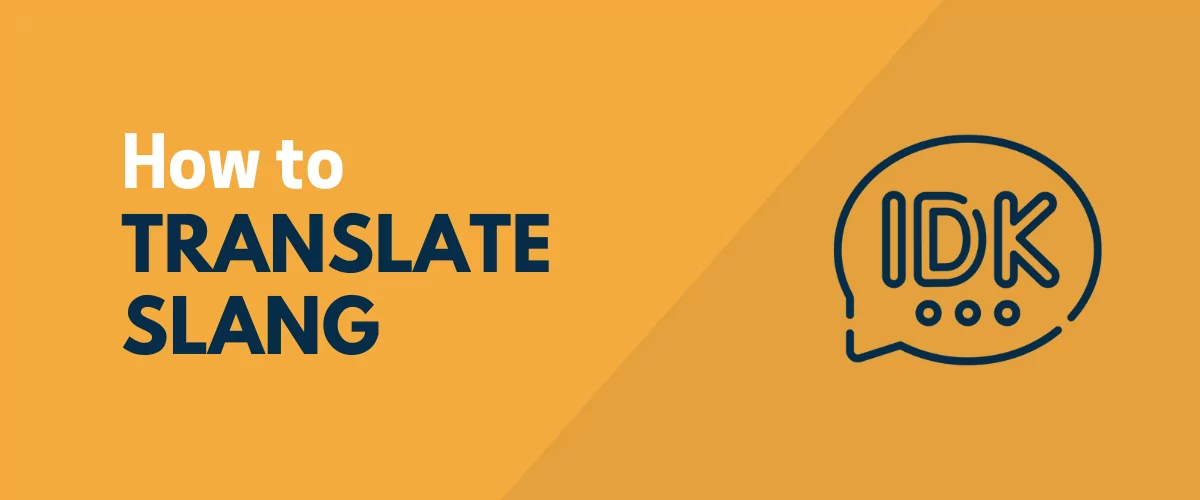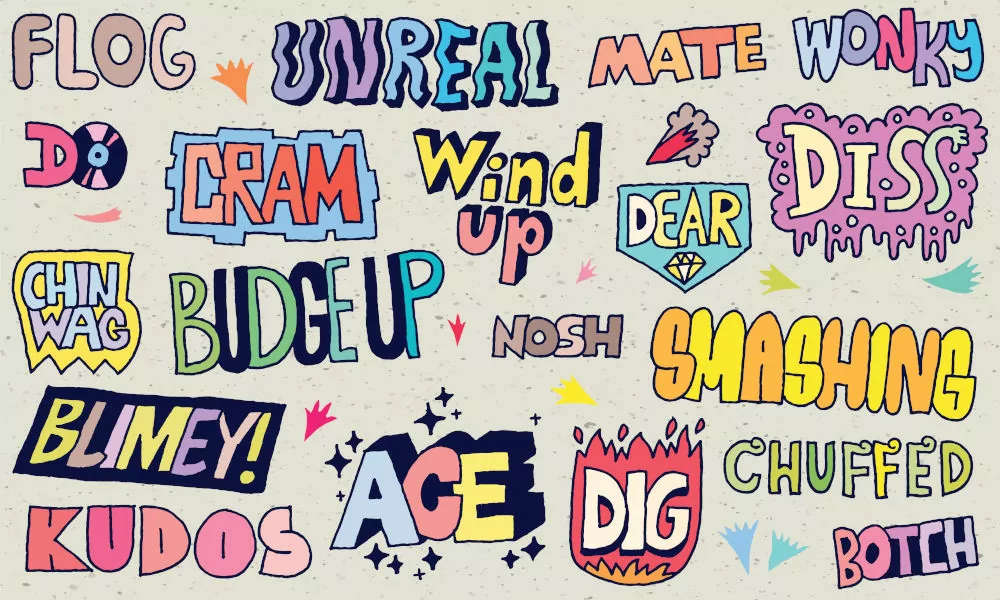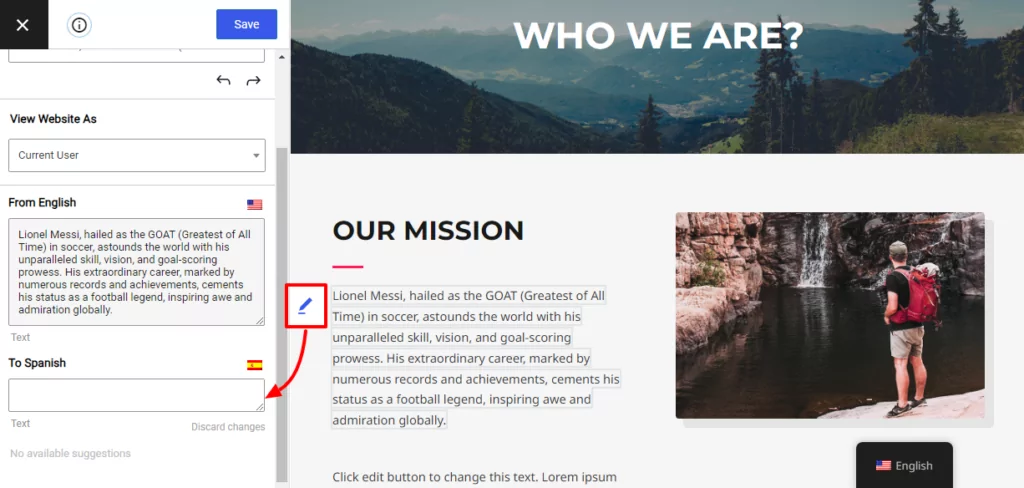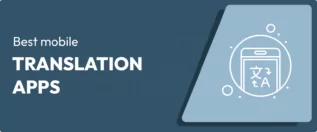
In this post
Are you having a hard time wrapping your head around slang translation? If that is a resounding yes, you’re not alone.
I think you will agree when I say translating slang poses several challenges for many translators.
We can also agree that adding slang to your content can spice up the conversation and make your text more relatable.
Inadvertently, we all use slang in everyday conversations with our peers. It has become so ingrained in our daily lives it’s sometimes hard to tell what is and isn’t slang.
But.
Still, many beginner and professional translators struggle with slang due to its informal and unpredictable nature.
What could be brilliant and well-meaning slang in one language could come off as confusing or offensive in another linguistic setting.
For instance, the slang phrases “let’s rock and roll” and “hit the road” will quickly make sense to most English speakers.
If you translated the phrases word-for-word, they wouldn’t make much sense to, say, Chinese or German speakers.
Another thing.
Some slang words and phrases in the source language don’t have equivalents in the target language, which makes matters worse.
Then you have cultural and social sensitivities to keep in mind when translating slang.
As you will learn later, these are some factors that make slang translation one of the hardest tasks for even the best translators.
So, how do you translate slang to another language while preserving the context and meaning of the original text?
In today’s post, you will learn:
- What is slang + popular examples;
- The challenges of translating slang;
- Why translate slang;
- Effective strategies to translate slang like a pro.
Without further ado, let us rock and roll (see what I did there?).
What is Slang?

So, good ladies and gents, what is slang?
Due to its ambiguous and polysemous nature, slang can take many different forms. This can make defining slang a tad confusing, folks.
In its most basic form, slang is casual, often colloquial language full of unusual expressions, phrases, words, wordplay, and humor.
It is mostly used within specific social groups or subcultures to convey veiled messages or validate a sense of belonging.
But don’t get me wrong.
Slang also includes loan words, swear words, made-up words, and professional jargon.
However,
Due to a lack of the standard characteristics of formal languages, slang presents almost unsurmountable problems for translators across the board.
Here are a few popular examples to illustrate what I mean.
Popular Examples of Slang
This is the fun part of this article, I promise 🙂 As a disclaimer, it’s full of slang that may not hold well. Just saying.
Let’s dive right in.
“You’re the GOAT” is a popular slang phrase, particularly with the younger generation. It means you’re the greatest of all time.
For example, “Lionel Messi is the GOAT in soccer.” Or perhaps Cristiano Ronaldo is more of your cup of tea. Whoever floats your boat (see what I did there again?).
If someone says you’re the GOAT, it means you’re awesome at what you do. But if you were to translate the phrase into Swahili, for instance, you’d get “wewe ni mbuzi,” which doesn’t convey the same meaning.
“Wewe ni mbuzi” means you’re a goat, the animal. It’s not the same meaning you wanted to pass from the source to the target language. It would definitely offend the intended readership.
Another popular example is the slang term “shit.” It has no literal meaning in formal English. When used as slang, however, it could mean a whole lot of things depending on the context.
For example, “you’re the shit” means you’re the absolute best; the real deal. “You’re shitting me” means you’re kidding me, and “That movie was shit” means the film was the absolute worst.
Again, if you translated “you’re the shit” into Swahili, you’d get “wewe ni shit,” which is derogatory slang meaning “you’re feces.” Not exactly what you intended for your target audience, right?
Note that even English-speaking countries or regions have different slang. For instance, “bum” in the US means a vagabond.
In the UK, the same slang word means someone’s nether regions. A “fag” in the UK means a cigarette, but the same word is a hateful slur against homosexuals in the US.
In the Oxford Learner Dictionary, “booty” means valuable goods that are stolen, especially by soldiers during a time of war.
But that’s definitely not what Samuel L. Jackson meant in the movie Shaft. Translating the slang word to another language literally will lose the intended meaning.
Even More Examples
In many movies and casual content, you will hardly encounter direct references to “marijuana.”
You will often see slang words such as “doobie,” “herb,” “chronic,” and other terms that wouldn’t make sense in another language.
Especially without proper and contextual translation.
Here’s another one.
American soldiers are familiar with many slang words that only make sense to them.
Terms like “grease monkey,” “squid,” “blue falcon” and “green bean” wouldn’t make the slightest of sense if translated to another language word-for-word.
And slang doesn’t stop there.
It extends to other professions such as medicine and law. Who would have guessed?
In clinical practice, for instance, you’ll often hear slang words such as “black holes,” “butterflies,” “rabbit” and “turkeys.”
Suffice it to say, none of these slang words mean what you think.
Translating such slang from the source language to the target language is a nightmare, especially since, I’m guessing, you’ve never seen medical slang before.
The above are just a few examples of slang, but I bet you see where I am going with this.
Slang is a nice communication tool when used within a specific group or culture. However, it presents challenges when translating in another language.
Now that you know what we are working with, here are some challenges of slang translation.
Challenges of Slang Translation

Translating slang is important for content localization.
Conveying the context and meaning of the original text in the target language will make your slang translations approachable and genuine.
That said, translating slang text poses several unavoidable challenges, including:
Rapid Evolution
Unlike formal languages such as English, slang evolves rapidly. Since it is predominantly emotive, there is always a need to coin new terms.
This presents a challenge for translators since you have to stay current with the latest words and their meanings.
Further, pop culture, social media, and messaging apps give birth to new terms, meaning slang is constantly changing.
Cultural Nuances
One of the biggest challenges of translating slang is cultural nuances. What is accepted as slang in one culture might be offensive (as a monkey in a negligee) to another group.
This means the translator requires cultural understanding to convey these nuances, which might be challenging if you’re from a different background.
On top of that, some slang words may be socially inappropriate across cultures. This means the translator must learn how to navigate cultural sensitivities carefully.
Without a good grasp of these cultural nuances, you will likely confuse or offend the target audience.
Ambiguity and Regional Variations
Most often, slang expressions have multiple meanings (polysemy) depending on context. This leads to ambiguity in translation and potential misunderstanding.
In addition, as we saw earlier, slang varies across regions. As such, translating regional slang precisely needs knowledge of local linguistic subtleties.
Moreover, slang often uses expressions that don’t have direct equivalents in the target language. This makes generating accurate translations difficult.
Another thing is that slang is highly contextual. For correct translations, you need a proper understanding of the situational or social context.
Generation Gap and Pop Culture Influence
Different age groups use and understand slang terms differently. This makes it difficult to bridge the generation gap and transfer the intended meaning successfully.
Additionally, slang is heavily influenced by pop culture, including music, movies, and social media. This means you must stay on top of these influences and trends for accurate translation.
For instance. A few years ago, OMG and LMAO slang terms weren’t prevalent. “I’m dead” didn’t exist either.
Lack of Formal Documentation
Unlike formal terms and expressions, slang is not extensively documented in official dictionaries.
For this reason, translators often have a difficult time finding reputable sources for reference.
To translate slang effectively, you need linguistic agility and a deep understanding of the cultural differences between various language pairs.
Now that you know the challenges many translators face, why should you bother translating slang?
Why Slang Translation?

Translating slang is a critical part of effective communication and understanding language.
Here are some solid reasons you should endeavor to translate slang effectively.
Improved Communication
Most times, slang reflects the cultural nuances of a specific group. Translating it bridges cultural gaps, which fosters improved cross-cultural communication.
If your target audience can understand and relate to the translated slang, you can accurately convey the intended meaning.
On the other hand, poorly translated slang leads to confusion and loss of meaning.
And the loss of your marketing dollars.
Avoiding Misinterpretations
First, slang is largely context-dependent. Translating with this in mind leads to translations that are appropriate for the intended situations.
In other words, you must use languages that are appropriate for different settings to avoid misunderstandings.
Secondly, you must understand different social groups have their own slang. Accurate translation allows people to engage effectively within these groups.
Thirdly, keep in mind that slang expressions are often polysemous (carrying multiple meanings). When you translate slang precisely, you avoid ambiguity and misinterpretations.
To mean, precise translation lets you choose suitable expressions to avoid offense. This is useful, especially if the source text contains culturally sensitive or inappropriate slang.
At the same time, properly translating slang is a fantastic way to show respect for the cultural diversity of the target audience.
This is critical when building trust and goodwill in a new demographic.
Maintaining Relevance
As a translator, you must do your best to remain relevant to compete favorably in the market. However, slang is highly dynamic and evolves rapidly.
Translating slang lets you stay current and maintain the relevance of your translations. Think of it like practice.
To stay ahead, keep an eye on pop culture, technology, and social media since they have a lot of influence on language evolution.
When all is said, translating slang allows you to understand and keep up with modern communication trends.
Effective Branding and Marketing
Laser-sharp targeting is an important part of any branding or marketing campaign. Miss the mark, and you will flush your money down the drain.
Understanding and properly translating slang allows you to target specific demographics with relatable campaigns.
You have probably seen big companies like Coca-Cola do this effectively.
Additionally, translating slang ensures that your advertising campaigns are culturally appropriate, preventing unintentional blunders.
Educational Purposes
When learning a new language, you will most likely want to learn the slang terms as well.
Translating slang helps learners understand colloquial expressions, which facilitates a more comprehensive grasp of the language.
Additionally, learning the slang of a specific region is a critical part of cultural education, which fosters a deeper appreciation for diversity.
Professional Settings
Did you know that “mouthpiece” is the slang term for a criminal defense lawyer? Now you know.
Slang that appears in legal documents and proceedings requires the services of a professional translator. This helps in accurate interpretation.
And that’s just the legal profession.
In other words, accurate slang translation is quintessential for clear and professional communication.
In summary, translating slang is crucial for effective communication, which contributes to fruitful interactions in personal and professional settings.
Effective Tips and Strategies for Slang Translation
Can’t wait to learn how to translate slang? If so, you will love the following section.
First, we delve into various tips for effective slang translation. After that, we will share three translation methods and conclude with one of the best translation plugins for WordPress.
Let us get down to business.
Top 5 Slang Translation Tips
To effectively translate slang, consider the following proven tips.
Immerse Yourself in the Culture
Quick question. How do you expect to translate English to French slang without understanding either culture?
We can agree it’s an uphill task. Right?
To effectively translate slang, take time to immerse yourself in the culture of the source language and the target audience.
This way, you will understand the origin, usage, and situational appropriateness of the slang.
Don’t hesitate to collaborate with native speakers and language experts.
Working closely with these individuals can help you learn more about the cultural and contextual nuances of the slang.
On top of that, language experts and native speakers can offer you valuable feedback about the accuracy and appropriateness of your slang translations.
Stay Updated and Engage in Continuous Learning
As we’ve hinted severally throughout the article, slang is a fast-paced environment. New terms, styles, and phrases surface every other day.
If you are to remain relevant and create effective translations, you must regularly update your knowledge of slang.
Staying in the loop lets you keep pace with evolving language trends and new slang expressions that you would have missed.
On top of that, keep in mind that slang translation is not a rigid process. Unlike normal languages, the slang landscape changes almost overnight.
As such, you should view slang translation as a continuous learning experience. Nothing is set in stone, so stay curious and receptive to new expressions and linguistic styles.
At the same time, stay flexible in your approach because slang is dynamic and may require creative adaptation to convey the intended meaning effectively.
Create Contextually Relevant Slang Translations
Literal word-for-word translations usually don’t work with slang since it’s often context-dependent.
Instead of translating just words, focus on the cultural, contextual, and situational meaning behind the slang.
This allows you to create slang translations that are relevant to the target audience.
Don’t shy away from analyzing the context in which the slang is used to determine its intended meaning and appropriateness in different scenarios.
Understand Pop Culture
To stay on top of your game, remember to familiarize yourself with popular culture references that influence slang. These include music, movies, TV shows, and social media trends.
Actively monitor social media grapevine where slang often originates and evolves. This will arm you with valuable insights into unconventional language use.
While at it, remember that different age groups and demographics use slang differently. This can help you fine-tune your translations accordingly.
Use Online Resources
While formal slang documentation may be hard to find, there are still tons of other resources you can use to polish your translations.
Consider using specialized slang dictionaries such as Urban Dictionary and Green’s Dictionary of Slang. You can find more language-specific slang dictionaries with a simple Google search.
For example, entering “slang dictionary” in the search engine will bring up several useful results.
Other than dictionaries, visit online forums and language communities to stay informed about the latest slang expressions. Reddit and Quora are great places to start.
For instance, I learned a lot about which languages have the most slang. I also discovered a brilliant Irish poet who uses a lot of slang in his works. You can’t blame me, I spent a lot of time on that thread 🙂
With the above tips, you can navigate the nuances of slang translation, ensuring clear and contextually appropriate translations.
With that out of the way, which methods do translators normally use for text slang translation? Continue reading to learn more.
Three Proven Methods of Slang Translation

We have already established that translating slang is important in effective cross-cultural communication. On top of that, we’ve shared a couple of useful tips to help you.
Seeing as you don’t want to omit the slang in your content for its flair, translators use one of the following three methods to translate slang.
The method you choose depends on your source and target languages, the type of content you’re translating, and the specific slang expressions you’re translating.
For best results, we recommend using a mix of the three.
Literal Slang Translation
As you can probably tell, literal translation involves translating slang terms and expressions word-for-word from the source text into the target language.
This is the easiest method of slang translation and might work with machine translation to some degree but for certain language pairs.
However, the literal translation method is not viable for languages that don’t have slang equivalents. In such cases, the translations will have a different meaning from the source text.
Take the popular “I’m dead” slang, for instance. In English, it means you find something extremely funny.
Doing a literal translation of this expression into other languages means you’ve passed away, which doesn’t make sense.
For example, “I’m dead” translates to “Estoy muerta” in Spanish, which wasn’t the intended meaning.
Stylistic Compensation
Secondly, we have stylistic compensation. This method of slang translation involves paraphrasing the original slang terms with contextually appropriate expressions from the target language.
This is the most common and effective method of slang translation since it takes into account the context of the original slang.
While it may lead to longer translations, it accurately conveys the meaning and context of the slang in the target language.
As a quick example, stylistic compensation could work for a slang expression, such as “I have plenty of dough.”
In US English slang, the word “dough” means money.
If you translated the slang expression into Spanish, you’d get “me sobra masa,” which means “I have leftover dough.”
Not money, but the dough you use in baking.
As you can see, the original meaning has been lost in the translation. This is where stylistic compensation comes in.
Using stylistic compensation, you can paraphrase the expression with equivalent slang from the target language.
The translation then becomes “tendo mucho plata.” Here, the word “plata” is Spanish slang for money.
Softening
And last but not least, we have softening. This method of translating slang involves toning down slang expressions and terms that are culturally offensive or inappropriate in the target language.
Say, for instance, you’d like to translate the slang expression “I won’t live in this crappy house anymore” into Spanish. “Crappy” here is vulgar slang that doesn’t translate well into Spanish.
A literal translation becomes “Ya no vivire mas en esta casa de mierda.” As you can see, the slang word “crappy” is replaced with “mierda,” which means “shit.”
As we saw earlier, “shit” means feces.
To soften this translation, you can soften the translation to “Ya no vivire mas en esta casa destartalada.”
If you translate this expression back to English, you get “I won’t live in this dilapidated house.”
I hope that makes sense.
Translating slang is hard as it is. This is why you need a formidable WordPress translation plugin such as TranslatePress.
A Case for TranslatePress Plugin for Slang Translation
The TranslatePress plugin is a versatile solution for website translations, including slang translation. It comes with a range of powerful features that help you translate all content on your website.
As far as translating slang goes, the plugin provides visual context to translations because of its intuitive translation editor, which looks like this:

With the above visual translation editor, you can fine-tune your slang translations manually. I say this because machine translations don’t catch the nuances of slang.
To help with this, TranslatePress comes with another nifty feature known as Translator Accounts. This add-on allows you to create or allow an existing user (or a professional) to translate slang with ease directly on the site without needing any coding skills.
The TranslatePress plugin comes with a whole lot more features that make translating slang a breeze. Notable features include:
- Image translation, meaning you can translate slang text in your images;
- Full support for Google Translate and Deepl;
- Customizable language switcher, so users can choose their preferred language easily;
- WooCommerce support;
- SEO pack, so you can drive more traffic from your translated slang content;
- And more.
If you want to translate slang on your WordPress site without breaking a sweat, I can’t think of a better translation plugin.
Besides, you have nothing to lose. There’s a free version of TranslatePress on WordPress.org that lets you test the waters.
TranslatePress Multilingual
Conclusion
Translating slang presents a lot of challenges to many translators. To overcome the challenges that come with slang translation, follow the tips we’ve shared above, and use your creativity to adapt translations for the intended audience.
Have you ever translated slang before? Did you face any challenges? How do you translate slang on your website? Please share your thoughts and suggestions in the comments section below.


